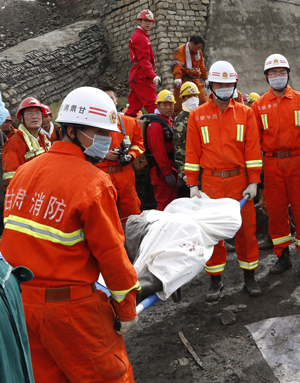Fractures had long plagued the rocky mountainside next to Huang Daihong’s home. When an earthquake jolted Luozehe County in Yunnan province, Huang watched a large black boulder release a shower of stones that instantly killed her neighbor.
The September 7 quake that struck the city of Zhaotong at 11 a.m. had a magnitude of 5.7 on the Richter scale, and an aftershock measured 5.6. All told, eighty-one people were killed.

The big black boulder that still rests near Huang’s home is a reminder for her and her neighbors that living in the area is dangerous.
The earth beneath Luozehe County has a range of geographical formations. At the center of the county is a village that spreads across a valley, and the Luozhe River runs through it. Most homes built in the area use supporting pillars propped against steep hills.
Cai Jihong, an elementary school teacher, said that when the quake struck, cracks suddenly began to appear on the school’s walls. He immediately rushed outside with students in his arms. Seconds later, the school building collapsed into a pile of rubble.
In the county’s north, seven houses near hillsides were crushed, survivors said. They also said children at a kindergarten were killed.
Huangpu Gang, chief of the Yunnan Provincial Seismological Bureau, said many homes in the area were poorly built. In addition, he said, geographic features in the area make it prone to disaster.
However, unlike the Wenchuan earthquake that struck Sichuan province in 2008, claiming more than 90,000 lives, most of the victims in Luozehe were killed by falling rocks, not collapsed buildings.
Since early this year, local authorities have identified 253 hazard areas where there were high risks of landslides, hill collapses, mudslides, and subsidence. However, despite efforts to step up warning measures, experts say risks were not addressed.
In another village, people responded to potential disaster by invoking higher powers: The community, with local donations, erected a carved Buddha statue in front of a rocky overhang. Later, however, a car-sized piece of rock from the overhang crushed two villagers’ houses.
Local mining has further destabilized ground in the area. Luozhe’s main coal mine areas have been a source of hazards since the late 1980s. Bulletins dating back to the early 1990s have been posted along the main street to warn residents of landslide dangers.
At a local cement factory, an aftershock claimed three lives on September 10. Trucks and cars were overturned by falling rocks. The manager of the plant said the factory was flooded by broken water pipes, resulting in damage estimated at 30 million yuan.
Despite the area’s poverty, Luozehe is known for its rich mineral deposits, with a coal reserve estimated at 240 million tons. The area’s lead and zinc ore deposits are among the largest in China.
Cai Jihong has lived in Luozehe for forty-three years and remembers when residents began using basic equipment to extract lead from raw ore in the 1990s. The local economy began to boom, and houses, restaurants, and small mineral processing plants were built along the river.
But over time, the mountainsides yielded less and less, and the natural disasters increased.
“We understand the mines brought us economic benefits,” said a farmer. “But the mountains were hollowed out.”
Xie Haitao and Liu Hongqiao are Caixin staff reporters. Hu Shilong is an intern reporter at Caixin.



